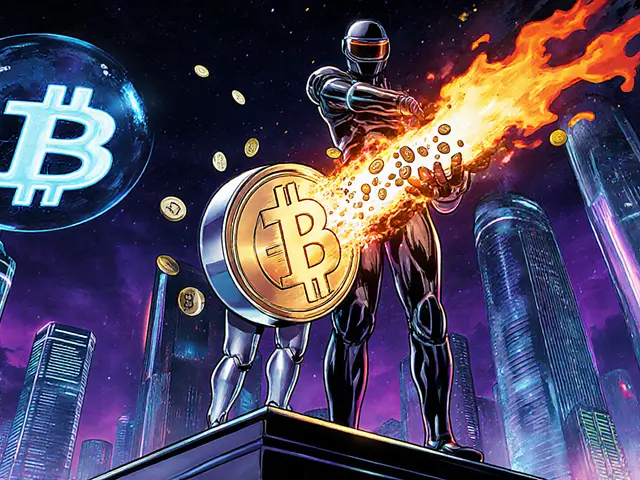TPRO Network Token Calculator
Current TPRO Metrics
Max Supply: 1.15 Billion TPRO
Circulating Supply: 1.14 Billion TPRO
Current Price: $0.00195
Market Cap: ~$1.2 Million
Burn-to-Access Model
Users must burn TPRO tokens to access premium features.
Each burn creates deflationary pressure.
Example: Burning 100 TPRO = Access to advanced trading signals.
Simulate Burn-to-Access Impact
AI Agent Overview
TPRO Network operates 7 distinct AI agent divisions:
- Trinity (Community Management) - Telegram chat monitoring
- Trading Bots - Automated trading on centralized exchanges
- Arbitrage Bots - Cross-exchange price arbitrage
- Social Influence Agents - Social media management
- NFT Management Specialists - NFT portfolio automation
- Business Development Agents - Partnership scouting
- Future Superintelligent DAO - Autonomous governance system
Burn-to-Access Model: Users destroy TPRO tokens to unlock premium features, creating deflationary pressure.
TPRO Network is a new crypto project that claims to be the first fully autonomous AI‑agent ecosystem. It mixes blockchain tech with a suite of AI bots that manage everything from trading to community engagement. If you’re wondering whether TPRO is just hype or a genuine utility token, this guide breaks it down in plain English.
Quick Facts
- Maximum supply: 1.15billion TPRO tokens
- Current circulating supply (Oct2025): ~1.14billion
- Chains: Ethereum and Polygon (cross‑chain support)
- Key use‑case: Burn‑to‑access model that powers autonomous AI agents
- Market cap: ~US$1.2million; ranks #1487 on Coinpaprika
What Is TPRO Network?
In the simplest terms, TPRO Network is a token‑driven platform that lets a collection of AI bots operate on a blockchain. The project originated from Tokenomia.pro, a token‑engineering consultancy that builds custom blockchain solutions for Web3 startups. Their vision is a "human‑AI collaboration" where the AI agents handle repetitive tasks-like market making, community moderation, or NFT portfolio management-while users keep control over the strategic direction.
Technical Foundations
The TPRO token lives on two major networks:
- Ethereum - the original smart‑contract platform, offering high security but higher gas fees.
- Polygon - a layer‑2 scaling solution that reduces transaction costs dramatically.
By being dual‑native, TPRO can tap into the massive developer ecosystem of Ethereum while offering cost‑effective transactions on Polygon. The token follows the ERC‑20 standard, which means it’s compatible with most wallets and exchanges that support those blockchains.
The Seven AI Agent Divisions
TPRO’s core selling point is its seven distinct AI‑agent categories. Each agent runs its own smart contract wallet and earns TPRO tokens for performing its designated tasks.
- Community Management - Trinity: This Telegram‑based bot monitors chat activity, scores user engagement, and pushes out friendly prompts to keep conversations lively.
- Trading Bots: Separate bots trade on centralized exchanges, each equipped with a bespoke algorithm and a performance‑based reward pool.
- Arbitrage Bots: They scan price differences across exchanges and execute rapid trades to capture spreads, feeding the rewards back into the ecosystem.
- Social Influence Agents: Seven personalities manage Instagram, Twitter, and Telegram accounts, each with a personal TPRO wallet for tipping.
- NFT Management Specialists: These agents automate buying, selling, and rebalancing of NFT collections based on market signals.
- Business Development Agents: They scout partnership opportunities, negotiate listings, and drive community growth initiatives.
- Future Superintelligent DAO: The long‑term goal is a Decentralized Autonomous Organization that can evolve the entire network without human intervention. DAO is the governance layer that will eventually coordinate the AI agents.
All agents operate under a "burn‑to‑access" model: users must destroy a fraction of their TPRO tokens to unlock premium features, such as higher‑frequency trading signals or exclusive NFT drops. This creates a built‑in deflationary pressure.

Tokenomics at a Glance
Below is a quick side‑by‑side look at the most relevant token metrics for TPRO, Ethereum, and Polygon.
| Metric | TPRO | Ethereum (ETH) | Polygon (MATIC) |
|---|---|---|---|
| Max Supply | 1.15B | Unlimited (dynamic) | 10B |
| Circulating Supply (Oct2025) | 1.14B | ≈120M | ≈9.5B |
| Current Price (USD) | $0.00195 | $1,850 | $0.86 |
| Market Cap | ~$1.2M | ~$211B | ~$8.2B |
| Primary Use‑Case | Fuel AI agents & burn‑to‑access | Smart contracts & DeFi | Scalable dApps & side‑chains |
Market Performance & Sentiment
TPRO’s market data shows a classic early‑stage crypto pattern: high volatility, modest liquidity, and a bearish technical outlook. According to CoinMarketCap, the token sits at roughly $0.00195, a 6% drop over the past 24hours. Trading volume swings between $13k and $80k depending on the data source, indicating limited depth on the order books.
Technical analysis on TradingView flags a "strong sell" on the daily timeframe and "sell" on weekly and monthly charts. The sentiment gap between the token’s innovative AI angle and its modest exchange coverage (mainly MEXC) suggests that investors are still wary of execution risk.
How to Get Started with TPRO
If you decide to test the waters, follow these steps:
- Set up a compatible wallet (MetaMask or Trust Wallet) and add the Ethereum and Polygon networks.
- Purchase a small amount of ETH or MATIC for gas fees.
- Visit the official TPRO website (no direct link required, just note the domain) and copy the contract address for the TPRO token.
- Use a decentralized exchange like Uniswap (Ethereum) or QuickSwap (Polygon) to swap ETH/MATIC for TPRO.
- Transfer the TPRO tokens to your wallet and join the official Telegram community where the Trinity bot greets newcomers.
- If you want premium access, burn the required amount of TPRO via the "Burn‑to‑Access" portal on the dashboard.
Remember, the token’s price is highly speculative. Treat any purchase as an experimental stake rather than a long‑term investment.
Risks & Considerations
- Liquidity constraints: Only a handful of exchanges list TPRO, meaning large trades can swing the price dramatically.
- Burn‑to‑Access friction: The model may deter smaller holders who can’t afford to destroy tokens for features.
- Execution risk: The AI agents are still in early development; real‑world performance may fall short of the roadmap promises.
- Regulatory uncertainty: Autonomous AI agents that trade or manage assets could attract future regulatory scrutiny.
- Market sentiment: Overall bearish crypto sentiment can amplify price drops regardless of project fundamentals.
Future Outlook
The roadmap mentions building a superintelligent DAO that can reprogram the entire ecosystem autonomously. While that sounds ambitious, the timeline is vague. Success hinges on three things: proving that the AI agents add measurable value, expanding listings beyond MEXC, and growing a vibrant user base that actually uses the burn‑to‑access utilities.
If the team can showcase a profitable trading bot or a high‑engagement NFT manager, the token might attract more speculative traders and perhaps institutional curiosity. Until then, TPRO remains a niche experiment at the intersection of AI and crypto.

Frequently Asked Questions
What blockchain does TPRO run on?
TPRO is an ERC‑20 token that lives on both Ethereum and Polygon networks, giving users the security of Ethereum and the low fees of Polygon.
How many TPRO tokens exist?
The maximum supply is 1.15billion tokens, with about 1.14billion already in circulation as of October2025.
What is the burn‑to‑access model?
To unlock premium features-like advanced trading signals or exclusive NFT drops-users must permanently destroy (burn) a specified amount of TPRO tokens, creating a deflationary effect.
Where can I trade TPRO?
TPRO is listed on MEXC and can be swapped on decentralized exchanges like Uniswap (Ethereum) or QuickSwap (Polygon) using the token contract address.
Is TPRO a good long‑term investment?
Investing in TPRO is high‑risk. Its value depends on the successful deployment of AI agents and broader adoption. Treat it as a speculative experiment rather than a core portfolio holding.




jeffrey najar
May 6 2025If you're diving into TPRO, the first thing to wrap your head around is the burn‑to‑access mechanic. It’s basically a way to lock up supply while giving you premium AI services. Think of it as a membership fee that actually reduces the token count, which can be a subtle bullish driver. Just make sure you have enough ETH or MATIC for gas before you start burning.
Rochelle Gamauf
May 7 2025The tokenomics brochure reads like a graduate‑level dissertation, yet the execution remains embarrassingly pedestrian.
Jonathan Tsilimos
May 8 2025The protocol’s utility vector is intrinsically linked to token sink dynamics.
Jerry Cassandro
May 9 2025A practical tip: keep an eye on the gas fees on Polygon, they’re usually a fraction of Ethereum and make the burn process much cheaper.
Aaron Casey
May 9 2025From a systems perspective, each AI division functions as a micro‑service that consumes TPRO as computational credit, so the more you burn, the higher the throughput you unlock.
Allie Smith
May 10 2025Honestly, it feels like you’re buying a ticket to a futuristic arcade where the bots do the heavy lifting for you, and you just watch the profits roll in.
Lexie Ludens
May 11 2025The architecture of TPRO reads like a sci‑fi novel sprayed with buzzwords.
Every AI division is touted as a revenue‑generating engine, yet the whitepaper offers scant empirical evidence.
When you burn tokens, you are essentially betting that the bots will produce value exceeding the cost of the burned supply.
In practice, the burn‑to‑access gate can alienate casual participants who lack the capital to sacrifice tokens.
Moreover, the deflationary pressure is only theoretical unless the network reaches critical mass.
The token’s market cap of just over a million dollars suggests that liquidity is thin and price manipulation is a real risk.
I’ve observed that the arbitrage bots claim to capitalize on price differentials, but without sizable order books those opportunities evaporate instantly.
The community management bot, Trinity, may keep chats lively, but its impact on token economics remains questionable.
From a philosophical standpoint, outsourcing decision‑making to autonomous agents raises concerns about accountability.
If the future superintelligent DAO ever materializes, who will be held responsible for potential losses?
The dual‑chain deployment on Ethereum and Polygon is clever for flexibility, yet it doubles the attack surface.
Security audits are mentioned, but the frequency and depth of those audits are not transparent.
Investors should also consider the regulatory environment, as AI‑driven trading could attract scrutiny.
In summary, the project is a bold experiment that mixes cutting‑edge AI with tokenomics, but the execution gap is wide.
Proceed with caution, allocate only what you can afford to lose, and keep a diversified portfolio.
Parker DeWitt
May 12 2025I think the whole AI‑agent hype is overblown 🚀🚀, but the burn model might actually force scarcity if people actually use it.
Shelley Arenson
May 13 2025Sounds like a fun experiment 😄, especially if the community can rally around the bots.
Lisa Stark
May 14 2025The DAO ambition sounds lofty but untested.
Logan Cates
May 15 2025What they don’t tell you is that every burn transaction is a data point for the hidden AI that could be feeding back to some unseen market maker.
Reid Priddy
May 16 2025Even if that were true, the token’s price would still be dictated by pure supply‑demand mechanics, not any secret algorithm.
Leah Whitney
May 17 2025If you’re skeptical, start small, burn a modest amount, and watch how the AI agents react before committing larger sums.
Kris Roberts
May 18 2025When I tried the trading bot for a week, the gains were modest but consistent, which hints that the underlying algorithms aren’t just smoke.
scott bell
May 19 2025I’m curious how the arbitration bots manage latency across exchanges they must be lightning fast to capture spreads
lalit g
May 20 2025Considering the cross‑chain nature of TPRO, it’s vital that users understand the different fee structures on Ethereum versus Polygon to make informed decisions.
Shamalama Dee
May 21 2025Remember, diversification is key; allocating a modest portion of your portfolio to experimental tokens can be educational, but never risk more than you can afford to lose.
Joel Poncz
May 21 2025i get why people are drawn to the novelty, but i always say keep an eye on liquidity before you dive deep.